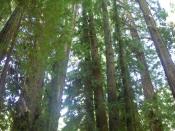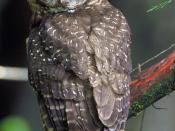The Northern Spotted Owl is a nocturnal bird with a 2 foot wingspan and weighing approximately two pounds. The owl lives in forests between British Columbia and San Francisco and prefers old growth forests. Old growth forests are over 200 years old. These forests have a complex ecosystem with larger trees than younger forests. The canopy these larger trees provide the owl with protection from predators.
The owl and their safe home face danger from the Pacific Northwest Logging Industry. The logging industry likes to log old growth forests because of the tree sizes. The forests are on federal land and the U.S. Forest Service use to auctions of the rights to cut down trees to loggers. This logging reduced the amount of old growth forests from 94 million acres to 30 million acres and reduced the number of breeding pairs of Spotted Owls to about 1500.
Environmentalists seeking to save the old growth forest used the spotted owl to stop logging.
They successfully petitioned the government to put the Spotted Owl on the endangered species list. Once the owl was considered endangered it became illegal to harass, harm or kill the animal and critical habitats became protected regardless of economic or political consequences. The Fish and Wildlife Service banned logging within 70 acres of a known spotted owls nest.
This greatly reduced the amount of logging on Federal land. Logging fell from 10.6 billion board feet in 1990 to less than 1 billion in 1992. Small town economies were devastated by drop in timber sales, saw mills across the region closed and unemployment rose as high as 20%. Lumber mills like Ochoco Lumbermill in Prineville, Oregon closed.
In 1994, the Northwest Forest Plan (NWFP) allowed logging in 80% of a 24 million area.. NWFP allowed 1.2 billion...


